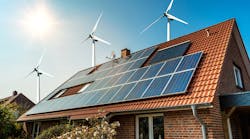Given their small scale, relatively low cost and predominantly renewable nature, distributed energy resources (DERs) represent what many consider to be the best solution for addressing our dual challenge: meeting carbon reduction targets and alleviating energy poverty.
But DERs are a challenge to most of the things we think we know about running the industry. From concepts of scale, system security and market operation to tariff design and data management, the prevalence of DERs mean we now need to re-imagine the electricity industry.
According to Dave Martin, the co-founder and managing director of Power Ledger Co., “Historically, the energy system followed a linear model. Generators generated and consumers consumed. Energy flowed from transmission and distribution networks to hungry customers. Fast forward to today and our energy system is no longer simply linear.”
Consumers are no longer just a source of demand that needs to be satisfied but often are a complex combination of supply and demand requirements. Generators are not just distant, heavy, spinning machines providing dispatchable gigawatts, inertia and emissions but they are increasingly the roofs of the homes and businesses that are the basis of demand.
Prosumers — so called because they produce and consume energy — are a new generation source. They are largely non-dispatchable, often community-scaled and connected at distribution voltages.
In an environment where it is increasingly possible and cost-effective for prosumers to efficiently generate and store the bulk of their energy needs themselves and where service industries are emerging to make energy self-sufficiency an achievable reality, DERs are edging us closer to distributed energy systems.
Worryingly, if the industry cannot present an attractive scenario to the owners of DERs to stay connected, we could reach the ultimate (and illogical) conclusion with the disintegration of power systems.
The industry needs to reconsider the long-held view of itself as a centrally-controlled and operated market to reflect the emerging physical reality of the industry — it being a series of dynamic, integrated and distributed energy markets with DERs playing an increasingly important and value-creating role at the distribution level.
Technology change, particularly the emergence of digital transactive technologies such as blockchain, creates the possibility to redesign the way we buy and sell energy, changes the nature of the agreements that support commercial transactions, and unlocks layers of value made available through the integration of DERs.
In a distributed market, agreements will not just be bilateral, there will be multilateral agreements of varying temporal nature, sometimes occurring simultaneously, sometimes seamlessly moving from one set of counterparties to another. For example, a residence with both solar PV and a battery could be trading their excess solar to their neighbor through a trading platform one minute, while providing power-quality-management services to the network through an aggregator the next.
Blockchain — a distributed ledger technology — can help manage this complex multiplicity of agreements, be it trading renewable energy or providing network control services for a network operator.
Current settlement and payment systems used by energy markets are characterized by a latency that will likely act to discourage DER owners from participating in a Virtual Power Plant (VPP) arrangements or in one of these other emerging markets.
DER owners need clear financial incentives and a frictionless settlement process.
Dave Martin built Power Ledger as an energy-trading platform powered by “a blockchain technology capable of facilitating such a complex transactive environment in close to real time.” Within a VPP scenario, the Power Ledger platform “acts as the transactive layer between the various functions of the VPP, providing for settlement between generators, distribution network operators, retailers, the wholesale market (if required) and consumers.”
At its simplest, blockchain can allow for the adoption of peer-to-peer trading arrangements that permit consumers to sell excess energy to their neighbors, thereby increasing the value proposition for distributed renewables and providing the opportunity for people who would otherwise be excluded from the DER economy to access low-cost and zero-carbon energy supplies.
The opportunities to alleviate energy poverty and improve energy resilience in at-risk communities are immense.
In more complex deployments, blockchain allows for the emergence of value creation opportunities between the owners of DER and end users, including network operators, demand aggregators and system operators.
Smart contracts can allow the DER owners to optimize the return they make from their investment in DERs, depending on the value placed on services by the end user.
These multi-party agreements may cease to persist after a service is provided or a trade is completed. Smart Contracts allow for the trustless, instantaneous settlement of these agreements.
According to Dave Martin, the Power Ledger platform functions “through the provision of data from advanced metering infrastructure and other sources. The platform can contribute to the visibility of behind-the-meter DER installations.”
Using close-to-real-time data from smart meters and other sensing devices, each transaction that occurs between the layers of services in a distributed market can be immutably recorded on the blockchain and the information relayed to market operators or network managers for system planning purposes.
The challenge for traditional energy systems now is not technology change; the electricity system has been developing and incorporating new technologies for over a century. The challenge we face today is a cognitive one. Can the industry change the way it sees itself after decades of a relatively consistent operating model?
The value case for blockchain is that they can be utilized to help manage the transition toward emerging distributed markets in a relatively seamless way. Blockchain will support the emergence of dynamic, integrated and distributed energy markets that, when operating in concert, will encourage small-scale, low-cost and zero-carbon distributed energy technologies to take us toward the energy future we need.


